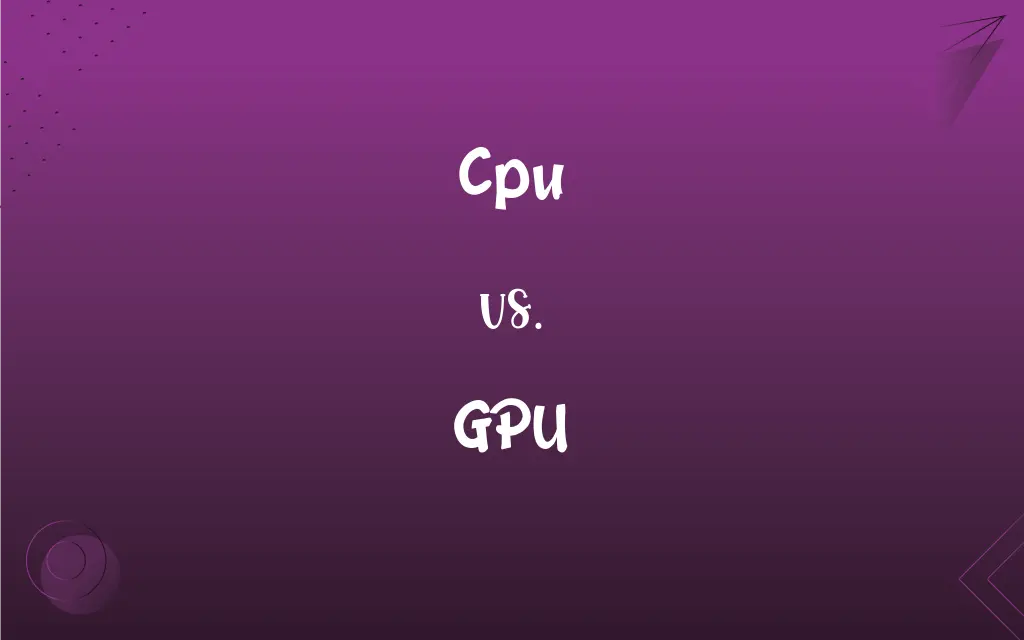CPU vs. GPU: What's the Difference?
Edited by Aimie Carlson || By Harlon Moss || Updated on October 19, 2023
A CPU (Central Processing Unit) manages all computer operations, while a GPU (Graphics Processing Unit) accelerates graphics and parallel tasks.

Key Differences
The CPU, or Central Processing Unit, often termed the "brain" of the computer, handles most general-purpose tasks and manages system operations. It ensures smooth functioning of software, user commands, and the operating system. The GPU, or Graphics Processing Unit, is specialized hardware mainly designed for rendering graphics and handling complex computations in parallel.
CPU architectures are optimized for tasks that require sequential processing, ensuring efficient execution of a wide variety of instructions. In contrast, the GPU's architecture focuses on parallelism, enabling it to process many calculations simultaneously, especially useful in graphics rendering where thousands of pixels are processed at once.
Most computers, whether desktop or laptop, will contain a CPU to manage standard operations. The presence of a GPU might be more variable. While all systems will have some form of graphics processing, dedicated GPUs are commonly found in gaming rigs or workstations that handle graphic-intensive tasks. On the other hand, CPUs are essential for all systems and are responsible for running the primary processes.
A CPU tends to have fewer cores (think of these as processing units) than a GPU. This distinction allows CPUs to be better at tasks that can't be easily broken down or parallelized. Conversely, GPUs might have hundreds or even thousands of smaller cores, making them suitable for tasks that can be divided and executed simultaneously, such as shading different pixels in an image.
While both CPU and GPU are integral parts of computer architecture, their roles and strengths are distinct. The CPU manages and delegates, ensuring all parts of the system work together effectively. The GPU, in contrast, takes on specialized tasks that benefit from parallel processing, offering acceleration especially in graphical endeavors.
ADVERTISEMENT
Comparison Chart
Primary Function
General-purpose processing
Graphics rendering & parallel computations
Architecture Focus
Sequential processing
Parallel processing
Core Count
Fewer, more powerful cores
Hundreds to thousands of smaller cores
Typical Presence in PCs
Essential in all systems
Optional, more common in gaming or graphics rigs
Task Specialization
Broad range of tasks
Graphical and parallel tasks
ADVERTISEMENT
CPU and GPU Definitions
Cpu
Often termed the "brain" of the computer, managing various operations.
A faster CPU can enhance the overall performance of a computer.
GPU
A specialized electronic circuit designed to accelerate image rendering and processing.
The GPU delivers superior graphics for gaming enthusiasts.
Cpu
The primary component of a computer responsible for interpreting and executing most commands.
The CPU interprets the software instructions to run a program.
GPU
Hardware optimized for parallel processing, often used in 3D graphics rendering.
Modern games require a powerful GPU to run smoothly.
Cpu
The primary unit that interprets computer program instructions and processes data.
The CPU works in tandem with RAM to execute applications.
GPU
An integral part of systems that require intensive graphical computations.
For deep learning tasks, a robust GPU is often recommended.
Cpu
The main logic unit of a computer system which manages system tasks.
Overheating can cause the CPU to throttle its performance.
GPU
An essential component in computers to enhance and manage visual content.
The video editing software leverages the GPU for faster rendering.
Cpu
A chip that handles the central processing of data in personal computers and other devices.
Upgrading the CPU can significantly boost the system's speed.
GPU
A processor dedicated to producing high-resolution graphics and videos.
With a dedicated GPU, the laptop displayed stunning visuals.
Cpu
The central processing unit, that part of the electronic circuitry of a computer in which the arithmetic and logical operations are performed on input data, which are thereby converted to output data; it is usually located on the mainboard, or motherboard, of a computer. The CPU and the memory form the central part of a computer to which the peripherals are attached. Most personal computers as of 1998 had only one CPU, but some computers may have more than one CPU.
Cpu
(computer science) the part of a computer (a microprocessor chip) that does most of the data processing; the CPU and the memory form the central part of a computer to which the peripherals are attached
FAQs
Which has more cores, a CPU or GPU?
A GPU typically has more cores than a CPU.
What does CPU stand for?
CPU stands for Central Processing Unit.
What's the primary role of a GPU?
The GPU's primary role is graphics rendering and handling parallel computations.
Can a computer run without a CPU?
No, a CPU is essential for a computer to function.
Is the CPU responsible for software execution?
Yes, the CPU interprets and executes software instructions.
What tasks primarily rely on the CPU?
Tasks like software execution, data computation, and system management rely primarily on the CPU.
Does a faster CPU mean a faster computer overall?
A faster CPU can enhance performance, but other factors like RAM and storage speed also matter.
Is a GPU only important for gamers?
While GPUs are crucial for gamers, they're also important for tasks like video editing and certain computational tasks.
Can a computer have more than one CPU?
Yes, some high-end workstations and servers have multiple CPUs.
Does a CPU handle graphics if there's no GPU?
Yes, CPUs with integrated graphics can handle basic graphical tasks.
Are GPUs essential for virtual reality applications?
Yes, VR applications require powerful GPUs for a smooth working.
Can a GPU be used for tasks other than graphics?
Yes, GPUs are also used for tasks that benefit from parallel processing, like some scientific computations.
How can I improve my computer's performance, by upgrading the CPU or GPU?
It depends on the tasks. For general performance, upgrade the CPU. For graphical tasks, upgrade the GPU.
Is the GPU responsible for displaying videos?
Yes, the GPU accelerates video rendering and playback.
What is integrated graphics?
Integrated graphics refers to a GPU that's built into the same chip as the CPU.
Are there different types of GPUs?
Yes, there are integrated GPUs (on the CPU chip) and dedicated GPUs (separate cards).
What role does the CPU play in multitasking?
The CPU manages and allocates resources, ensuring smooth multitasking.
Why might graphic designers need a powerful GPU?
A powerful GPU ensures smoother graphics rendering and faster design software performance.
Do all computers have a dedicated GPU?
No, not all computers have a dedicated GPU; many use integrated graphics within the CPU.
Can GPUs be used in artificial intelligence and machine learning?
Yes, GPUs are often used in AI and machine learning due to their parallel processing capabilities.
About Author
Written by
Harlon MossHarlon is a seasoned quality moderator and accomplished content writer for Difference Wiki. An alumnus of the prestigious University of California, he earned his degree in Computer Science. Leveraging his academic background, Harlon brings a meticulous and informed perspective to his work, ensuring content accuracy and excellence.
Edited by
Aimie CarlsonAimie Carlson, holding a master's degree in English literature, is a fervent English language enthusiast. She lends her writing talents to Difference Wiki, a prominent website that specializes in comparisons, offering readers insightful analyses that both captivate and inform.































































